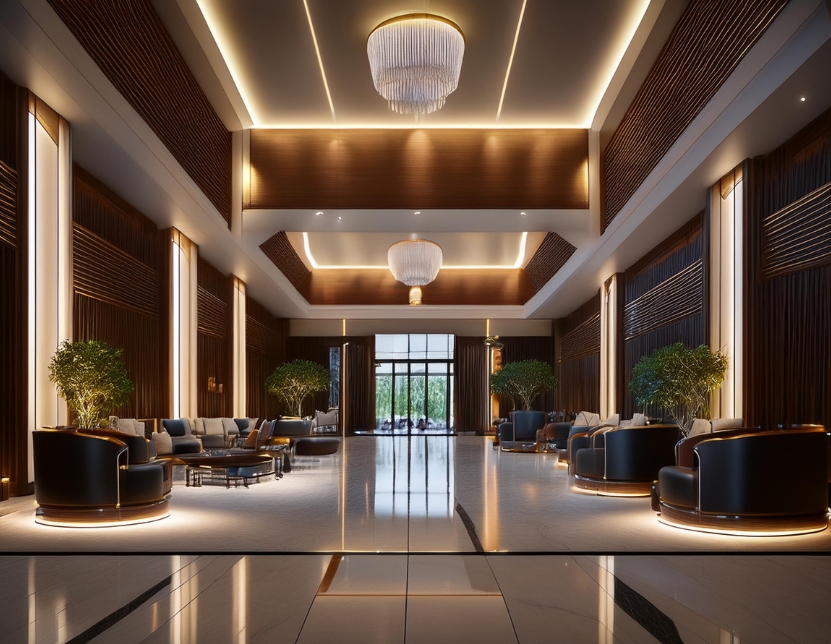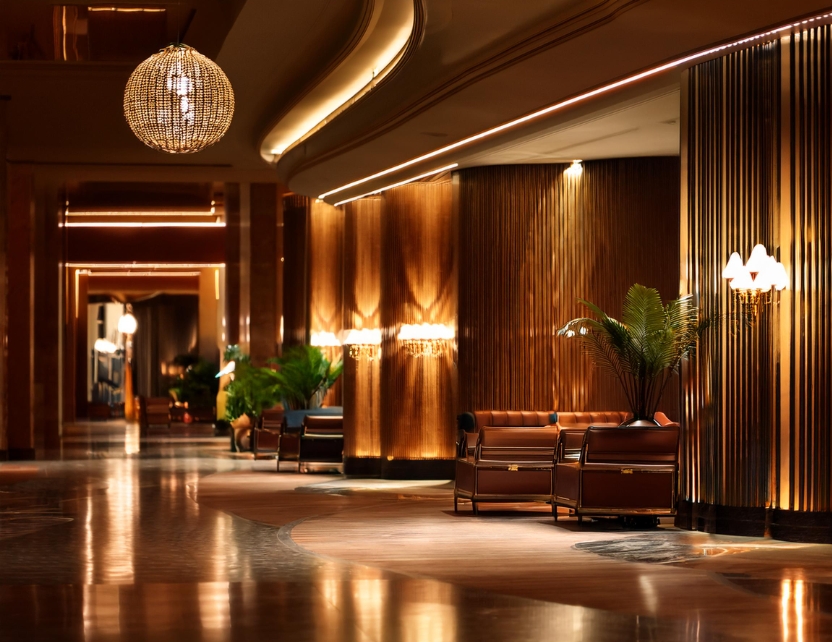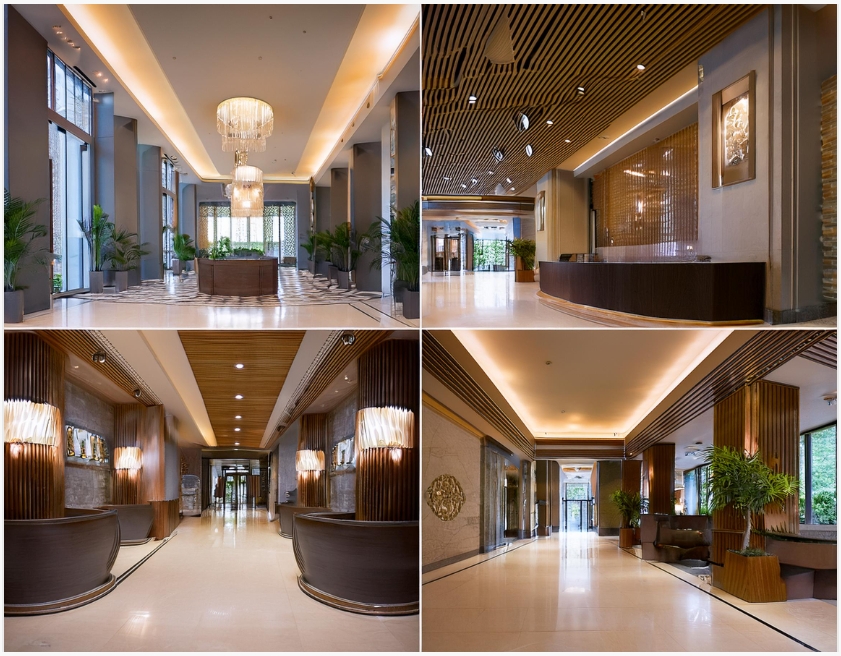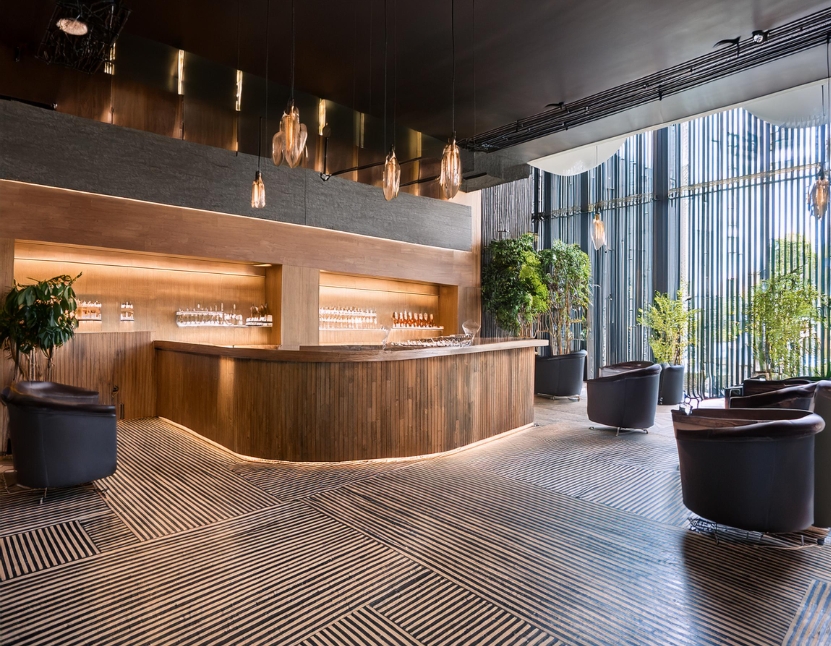- 14
- Aug
Transforming Hotel Lobbies Bar: Innovative Lighting Solutions for Day and Night
Lighting Design in Hotel Lobbies: Adapting to Day and Night for Optimal Guest Experience
Hotel lobby lighting plays a pivotal role in shaping a guest’s first impression and overall experience. As many five-star hotels undergo renovations, particularly those built in the 1990s, the focus often turns to improving the lobby’s lighting. Historically, these lobbies were designed with natural lighting in mind, but indoor artificial lighting often fell short, leading to several challenges:

Common Challenges in Existing Hotel Lobby Lighting
- Insufficient Indoor Lighting: On bright days, guests transitioning from outdoor to indoor spaces may experience discomfort due to a stark contrast in lighting levels. The current setup often lacks the flexibility to adapt to varying natural light conditions.

- Unbalanced Key Lighting: Older lighting designs typically followed a uniform approach, with fixtures arranged at equal distances on the ceiling without considering the specific areas they illuminate. This led to:
- Obscured Furnishings: Centerpieces and other important decor items often blend into the background, failing to stand out due to poor lighting placement.
- Difficulty Navigating Functional Areas: Guests may struggle to locate key areas like the reception desk, elevators, or seating due to inadequate lighting.
- Over-reliance on Decorative Chandeliers: Large chandeliers, while aesthetically pleasing, often became the primary light source, overpowering functional lighting needs.
- Glare in Rest Areas: Improper light placement in seating areas can cause discomfort, making these spaces less inviting for guests to relax.
Modern Hotel Lobby Lighting: A New Approach
- To meet the evolving expectations of guests, modern hotel lobby lighting must go beyond the standards set a decade ago. Here are key considerations for designing lighting in contemporary hotel lobbies:
- Understanding the Project Type: Determine whether the hotel is a traditional star-rated establishment or a modern boutique hotel. This distinction will guide the overall lighting approach, ensuring it aligns with the hotel’s brand identity.
- Creating a Welcoming Environment: The lobby serves as the hotel’s “business card.” Effective lighting should enhance the communication process between guests and staff, making the space feel welcoming and comfortable. The design should focus on the relationship between people and light, tailoring the visual environment to guests’ needs throughout the day.
Layered Lighting Design:
- Primary Lighting: Start by establishing a foundational light environment that caters to the general activities and needs of guests.
- Accent Lighting: Once the basic lighting is in place, introduce secondary lighting elements to create specific moods and highlight architectural features or important areas.
- Adapting to Different Styles: Modern hotel lobbies are diverse and often feature unique design elements that cannot be easily categorized as “European classic” or “modern minimalist.” Lighting designers must be versatile, able to create effects that range from bright and colorful to calm and serene, depending on the desired ambiance.
- Collaborating with Interior Designers: Successful lighting design is achieved through close collaboration with interior designers. This partnership ensures that the lighting plan complements the overall design vision, enhancing the hotel’s brand identity.
Differentiating Hotel Brands Through Lighting
Lighting can also play a crucial role in distinguishing one hotel brand from another. Traditional hotels often feature tall, expansive lobbies with luxurious chandeliers, where the lighting creates a calm and comfortable atmosphere. In these spaces:

Downlighting provides ample light for work surfaces.
- Ambient lighting is achieved through indirect sources like decorative chandeliers, table lamps, and floor lamps.
- Reception Area: Lighting at the reception desk should be sufficient to allow clear communication between guests and staff, without compromising privacy.
In contrast, modern hotels, particularly design-focused brands, tend to have smaller lobbies with more dynamic lighting needs. Here, the reception desk may require higher illumination levels (500-800 lux) to facilitate various tasks. The background wall, a focal point guiding guests’ attention, should be highlighted using techniques such as wall washing and backlighting.
Lighting the Lobby Bar
The lobby bar also requires careful consideration. In traditional hotels, the bar’s illumination is typically lower than the lobby’s to create a more intimate setting for conversation and relaxation, primarily through indirect lighting. Modern hotel lobby bars, however, are multifunctional spaces where guests might meet, work, or even dine. The lighting system should be versatile, capable of providing different levels of illumination based on the activity, creating an environment that is both relaxed and functional.

As a lighting designer with a decade of experience, creating an effective lighting scheme for a modern simple lobby bar requires a blend of functionality, aesthetics, and adaptability. Here\u2019s a detailed guide to achieving a sophisticated and practical lighting design for a modern simplicity-themed lobby bar.
-
Understand the Space and Functionality
Define the Bar\u2019s Purpose: In a modern simplicity lobby bar, the space often serves multiple functions\u2014socializing, dining, and sometimes working. The lighting design must adapt to these varying uses, providing flexibility to switch between relaxed ambiance and functional illumination as needed.
Spatial Layout: Analyze the layout to identify key areas such as the bar counter, seating zones, and pathways. The design should enhance these areas while maintaining a cohesive and uncluttered look, characteristic of modern simplicity.
-
Establish Layered Lighting
A. Ambient Lighting: Start with a base layer of ambient lighting that provides even illumination across the entire space. For a modern simplicity design, opt for recessed LED fixtures or concealed lighting channels integrated into ceiling designs. These fixtures offer a clean look without visible hardware, aligning with the minimalist aesthetic.
- \u00a0\u00a0\u00a0Recommended Fixtures: Slim LED downlights or linear LED fixtures.
- \u00a0\u00a0\u00a0Color Temperature: Use a neutral white (around 3000K) to maintain a clean and modern feel.
B. Accent Lighting: Introduce accent lighting to highlight specific features like the bar counter, artwork, or architectural details. This can be achieved with adjustable LED spotlights or narrow-beam LED strips that draw attention to focal points without overpowering the space.
- \u00a0Recommended Fixtures: Adjustable LED track lights or embedded LED strips.
- \u00a0Focus Areas: Bar counter edges, wall art, and unique architectural elements.
C. Task Lighting: Incorporate task lighting around the bar counter to ensure adequate visibility for bartenders and guests. This is crucial for a multifunctional space where detailed tasks, such as mixing drinks or reading menus, take place.
- \u00a0Recommended Fixtures: Pendant lights with dimming options or adjustable LED fixtures.
- \u00a0Lighting Levels: Aim for around 500-800 lux at the bar counter for optimal visibility.
-
Implement Dimmer Controls
Flexibility in Lighting Levels: Integrate dimmable lighting controls to adjust the ambiance throughout the day and night. This allows the bar to transition smoothly from a bright, energetic environment during the day to a softer, more intimate setting in the evening.
- \u00a0Recommended Controls: Smart dimmers or digital lighting control systems that can be programmed for different times of day or events.
- User Experience: Ensure the dimming controls are user-friendly and accessible to both guests and staff, allowing for quick adjustments as needed.
-
Focus on Minimalist Design
- Concealed Fixtures: Emphasize simplicity by using fixtures that blend seamlessly into the architecture. Recessed lighting, hidden LED strips, and built-in channels help maintain an uncluttered look, aligning with modern simplicity.
- Streamlined Designs: Choose fixtures with clean lines and minimalistic designs. Avoid overly decorative elements that can detract from the simple, elegant aesthetic.
- Color and Finish: Opt for neutral colors and finishes that complement the overall design scheme. Matte black, brushed metal, or white finishes typically work well in modern simplicity settings.
-
Enhance Comfort and Atmosphere
- Avoid Glare: Position lighting fixtures to minimize glare and ensure comfortable lighting for all areas, particularly seating zones. Use diffusers or soft light sources to create a pleasant environment.
- Create Zones: Designate different lighting zones within the bar area to cater to various activities. For example, provide softer, ambient lighting for seating areas and brighter, focused lighting for the bar counter.
- Integrated Solutions: Consider incorporating lighting solutions that can be easily adjusted or repositioned to accommodate changing needs or special events, ensuring versatility without compromising the minimalist design.
-
Consider Energy Efficiency
- LED Technology: Use energy-efficient LED lighting to reduce operating costs and environmental impact. LEDs provide long-lasting performance and are available in various styles and color temperatures to suit modern simplicity designs.
- Smart Controls: Implement energy-saving features such as motion sensors or timers to ensure that lights are used efficiently and only when needed.
Designing a modern simplicity lobby bar requires a thoughtful approach to lighting that balances functionality, aesthetics, and adaptability. By focusing on layered lighting, minimalist fixtures, and practical controls, you can create an inviting and versatile space that enhances the guest experience and aligns with contemporary design principles.
Conclusion
As hotel lighting design continues to evolve, it is essential to move beyond outdated standards and embrace more nuanced, flexible approaches. By considering the specific needs of guests, the unique characteristics of each hotel, and the importance of collaboration between lighting and interior designers, hotels can create lobby environments that are both visually stunning and highly functional, day or night.
___________________________________________________________________________________________________________________
Designer: Alex Johnson, Senior Lighting Designer, LEDER Company
Contact Us
For more information on how to elevate your hotel lobby lighting or to place an order, please contact us at LEDER Company. Our team is ready to assist you in creating an exceptional lighting experience that aligns with your brand\u2019s vision.
Email: hello@lederillumination.com
Phone/WhatsApp: +8615815758133
Website:https://lederillumination.com/
We look forward to working with you to bring your lighting vision to life!
